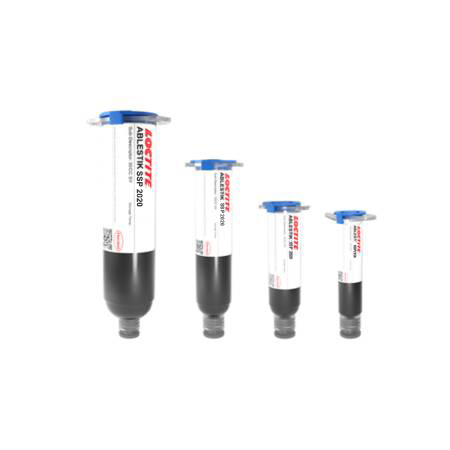LOCTITE ABLESTIK SSP 2020
- High thermal conductivity
- High electrical conductivity
- High die shear strength
Product Description
LOCTITE® ABLESTIK SSP 2020 Silver sintering die attach adhesive is designed for devices requiring high thermal and electrical conductivity.It can reach around 200 W/mK when pressure is applied during sintering, making it one of the most thermally conductive die attach materials available. The only thing that can potentially go higher than that is pure silver at 400 W/mK. Please note that SSP stands for Silver Sintering and not semi sintering.
LOCTITE ABLESTIK SSP 2020 is formulated to provide high heat transfer generated from power devices and maintain high adhesion at operating temperatures as high as 260ºC. It is a solvent based silver sintering material that is typically not suitable for semiconductor die attach MSL requirements.
Technical Specifications
| General Properties | |||||||||||||
| |||||||||||||
| Work life @25°C Work life @25°C Work life is the amount of time we have to work with a material until it is no longer able to be easily worked and applied on a substrate. It is based on the change in viscosity and it can rely on the application requirements. | 18 hours | ||||||||||||
| Physical Properties | |||||||||||||
| Thixotropic index Thixotropic index Thixotropic Index is a ratio of a material s viscosity at two different speeds in Ambient temperature, generally different by a factor of ten. A thixotropic material s viscosity will decrease as agitation or pressure is increased. It indicates the capability of a material to hold its shape. Mayonnaise is a great example of this. It holds its shape very well, but when a shear stress is applied, the material easily spreads. It helps in choosing a material in accordance to the application, dispense method and viscosity of a material. | 5.0 | ||||||||||||
| Viscosity Viscosity Viscosity is a measurement of a fluid’s resistance to flow. Viscosity is commonly measured in centiPoise (cP). One cP is defined as the viscosity of water and all other viscosities are derived from this base. MPa is another common unit with a 1:1 conversion to cP. A product like honey would have a much higher viscosity -around 10,000 cPs- compared to water. As a result, honey would flow much slower out of a tipped glass than water would. The viscosity of a material can be decreased with an increase in temperature in order to better suit an application | 19,000 mPa.s | ||||||||||||
| Chemical Properties | |||||||||||||
| |||||||||||||
| Mechanical Properties | |||||||||||||
| |||||||||||||
| Electrical Properties | |||||||||||||
| Volume Resistivity Volume Resistivity Volume resistivity, also called volume resistance, bulk resistance or bulk resistivity is a thickness dependent measurement of the resistivity of a material perpendicular to the plane of the surface. | 4.8x10-5 Ohms⋅cm | ||||||||||||
| Thermal Properties | |||||||||||||
| Thermal Conductivity Thermal Conductivity Thermal conductivity describes the ability of a material to conduct heat. It is required by power packages in order to dissipate heat and maintain stable electrical performance. Thermal conductivity units are [W/(m K)] in the SI system and [Btu/(hr ft °F)] in the Imperial system. | >100 W/m.K | ||||||||||||
Additional Information
Pressureless Sintering Process
Ag or Au Leadframe sinter
- 10 minute ramp to 250°C + 60 minutes @ 250°C (Conventional Air Circulated Oven)
- 10 minute ramp to 250°C + 60 minutes @ 250°C (N2 Oven)
Direct Bonded Copper (DBC)
- 10 minute ramp to 200°C + 60 minutes @ 200°C (on Au)
- 10 minute ramp to 250°C + 60 minutes @ 250°C (on Ag)
Pressure Sintering Process
Air dry 40 minutes @ 120ºC then sinter 2 minutes @ ≥250 °C at >10 MPa pressure



